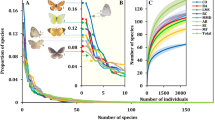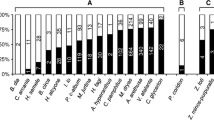Abstract
Standardised biodiversity assessment is crucial to understand community structures and population dynamics of animals. There exist various methods to monitor biodiversity. Approaches differ depending on the target species group and the aim of study, and show advantages and disadvantages. The obtained data and results are influenced by local environmental conditions and seasonal variability. In a comparative approach, we studied butterfly diversity and community structure in the dryland savannah biome of south-eastern Kenya with two different methods, transect counts and bait trapping. We repeatedly collected data throughout the dry and rainy seasons, in both near natural and anthropogenically influenced landscapes. Significantly more species and individuals were recorded by transect counts than by bait trapping, though the larger and more mobile Nymphalid species (and in particular representatives of the genus Charaxes) were comparatively overrepresented in traps. The transect data revealed much more pronounced effects of land-use and seasonality than the trap data. These results show that the choice of data collection methods must depend on the general research question, habitat conditions and season. To study the relative variation of species diversity and abundance, the collection of a fraction of the total species diversity might be sufficient. However, if the focus is on a largely complete recording of species diversity, the use of various collection methods is essential. More specifically, our data clearly demonstrate that transect counts represent a reasonable method for assessing butterfly diversity for the African dryland savannah region, but fails to fully capture occurrences of all species. Bait trapping can be used only as a supplementary method for assessing some few highly mobile low-density species.




Similar content being viewed by others
Data availability
All raw data are available as electronic appendix.
References
Barlow J, Araujo IS, Overal WL, Gardner TA, da Silva MF, Lake IR, Peres CA (2008) Diversity and composition of fruit-feeding butterflies in tropical Eucalyptus plantations. Biodivers Conserv 17:1089–1104
Beck J, Linsenmair KE (2006) Feasibility of light-trapping in community research on moths: attraction radius of light, completeness of samples, nightly flight times and seasonality of Southeast-Asian hawkmoths (Lepidoptera: Sphingidae). J Res Lepidoptera 39:18–37
Berwaerts K, Van Dyck H, Aerts P (2002) Does flight morphology relate to flight performance? An experimental test with the butterfly Pararge aegeria. Funct Ecol 16:484–491
Birkhofer K, Gossner MM, Diekötter T, Drees C, Ferlian O, Maraun M, Scheu S, Weisser WW, Wolters V, Wurst S, Zaitsev AS, Smith HG (2017) Land-use type and intensity differentially filter traits in above- and below-ground arthropod communities. J Anim Ecol 86:511–520
Burnham KP, Overton WS (1978) Estimation of the size of a closed population when capture probabilities vary among animals. Biometrika 65:623–633
Caldas A, Robbins RK (2003) Modified Pollard transects for assessing tropical butterfly abundance and diversity. Biol Conserv 110:211–219
Checa MF, Donoso DA, Rodriguez J, Levy E, Warren A, Willmott K (2019) Combining sampling techniques aids monitoring of tropical butterflies. Insect Conserv Divers 12:362–372
Colwell RK, Chao A, Gotelli NJ, Lin S-Y, Mao CX, Chazdon RL, Longino JT (2012) Models and estimators linking individual-based and sample-based rarefaction, extrapolation, and comparison of assemblages. J Plant Ecol 5:3–21
Dennis RLH (2010) A resource-based habitat view for conservation: butterflies in the British landscape. Wiley-Blackwell, Chichester
DeVries PJ, Walla TR, Greeney HF (1999) Species diversity in spatial and temporal dimensions of fruit-feeding butterflies from two Ecuadorian rainforests. Biol J Lin Soc 68:333–353
Dixon P (2003) VEGAN, a package of R functions for community ecology. J Veg Sci 14:927–930
Ehl S, Ebertshäuser M, Gros P, Schmitt T (2017) Population demography of alpine butterflies: Boloria pales and Boloria napaea (Lepidoptera: Nymphalidae) and their specific adaptations to high mountain environments. Acta Oecologica 85:53–61
Ehl S, Hostert K, Korsch J, Gros P, Schmitt T (2018) Sexual dimorphism in the alpine butterflies Boloria pales and Boloria napaea: differences in movement and foraging behavior (Lepidoptera: Nymphalidae). Insect Sci 25:1089–1101
Freitas AVL, Brown KS (2004) Phylogeny of the Nymphalidae (Lepidoptera). Syst Biol 53:363–383
Freitas A, Iserhard C, Dos Santos J, Carreira J, Ribeiro D, Melo D, Rosa A, Marini-Filho O, Accacio G, Uehara-Prado M (2014) Studies with butterfly bait traps: an overview. Revista Colombiana De Entomología 40:209–218
Gower JC (1966) Some distance properties of latent root and vector methods used in multivariate analysis. Biometrika 53:325–338
Habel JC, Seibold S, Ulrich W, Schmitt T (2018a) Seasonality overrides differences in butterfly species composition between natural and anthropogenic forest habitats. Anim Conserv 21:405–413
Habel JC, Teucher M, Schmitt T, Ulrich W (2018b) Documenting the chronology of declining ecosystem health along East African rivers. Remote Sens Ecol Conserv 4:34–43
Hamer KC, Hill JK, Benedick S, Mustaffa N, Sherratt TN, Maryati MKCV (2003) Ecology of butterflies in natural and selectively logged forests of northern Borneo: the importance of habitat heterogeneity: Bornean forest butterflies. J Appl Ecol 40:150–162
Hausmann A, Segerer AH, Greifenstein T, Knubben J, Mornière J, Bozicevic V, Doczkal D, Günter A, Ulrich W, Habel JC (2020) Towards a standardized quantitative and qualitative insect monitoring scheme. Ecol Evol 10:4009–4020
Iserhard CA, Brown KS, Freitas AVL (2013) Maximized sampling of butterflies to detect temporal changes in tropical communities. J Insect Conserv 17:615–622
Jaetzold R, Hornetz B, Shisanya CA, Schmidt H (2007) Farm management handbook of Kenya. Volume II: Natural conditions and farm management information, Part C: East Kenya. Subpart C1: Eastern Province. Ministry of Agriculture, Deutsche Gesellschaft für Technische Zusammenarbeit (GTZ), Eschborn, Nairobi
Jakubikova L, Kadlec T (2015) Butterfly bait traps versus zigzag walks: what is the better way to monitor common and threatened butterflies in non-tropical regions? J Insect Conserv 19:911–919
Kadlec T, Tropek R, Konvicka M (2012) Timed surveys and transect walks as comparable methods for monitoring butterflies in small plots. J Insect Conserv 16:275–280
Krahner A, Schmidt J, Maixner M, Porten M, Schmitt T (2021) Evaluation of four different methods for assessing bee diversity as ecological indicators of agro-ecosystems. Ecol Indic 125:107573
Kral KC, Hovick TJ, Limb RF, Harmon JP (2018) Multi-scale considerations for grassland butterfly conservation in agroecosystems. Biol Conserv 226:196–204
Larsen TB (1996) The butterflies of Kenya and their natural history. Oxford University Press, Oxford
Launer AE, Murphy DD (1994) Umbrella species and the conservation of habitat fragments: a case of a threatened butterfly and a vanishing grassland ecosystem. Biol Conserv 69:145–153
Merckx T, Slade EM (2014) Macro-moth families differ in their attraction to light: implications for light-trap monitoring programmes. Insect Conserv Divers 7:453–461
Merckx T, Feber R, Hoare D, Parsons M, Kelly C, Bourn N, Macdonald D (2012) Conserving threatened Lepidoptera: towards an effective woodland management policy in landscapes under intense human land-use. Biol Conserv 149:32–39
Merckx T, Huertas B, Basset Y, Thomas JA (2013) A global perspective on conserving butterflies and moths and their habitats. In: Macdonald DW, Willis KJ (eds) Key topics in conservation biology. Wiley, Oxford, pp 237–257
Merckx T, Kaiser A, Van Dyck H (2018) Increased body size along urbanization gradients at both community and intraspecific level in macromoths. Glob Change Biol 24:3837–3848
Molleman F, Kop A, Brakefield PM, De vries PJ, Zwaan BJ (2006) Vertical and temporal patterns of biodiversity of fruit-feeding butterflies in a tropical forest in Uganda. Biodivers Conserv 15:107–121
Munyuli MBT (2013) Drivers of species richness and abundance of butterflies in coffee–banana agroforests in Uganda. Int J Biodivers Sci Ecosyst Serv Manag 9:298–310
New T (2011) Launching and steering flagship Lepidoptera for conservation benefit. J Threat Taxa 3:1805–1817
Nowicki P, Settele J, Henry P-Y, Woyciechowski M (2008) Butterfly monitoring methods: the ideal and the real world. Israel J Ecol Evol 54:69–88
Nzau JM, Gosling E, Rieckmann M, Shauri H, Habel JC (2020) The illusion of participatory forest management success in nature conservation. Biodivers Conserv 29:1923–1936
Oksanen J, Blanchet FG, Friendly M, Kindt R, Legendre P, McGlinn D, Minchin PR, O'Hara RB, Simpson GL, Solymos P, Stevens MHH, Szoecs E, Wagner H (2019) vegan: Community Ecology Package. R package version 2.5-6. https://CRAN.R-project.org/package=vegan
Pollard E (1977) A method for assessing changes in the abundance of butterflies. Biol Conserv 12:115–134
R Core Team (2020) R: a language and environment for statistical computing. R Foundation for Statistical Computing, Vienna, Austria. https://www.R-project.org/.
Schmitt T, Ulrich W, Büschel H, Bretzel J, Gebler J, Mwadime L, Habel JC (2020) The relevance of cloud forest fragments and their transition zones for butterfly conservation in Taita Hills, Kenya. Biodivers Conserv 29:3191–3207
Schmitt T, Ulrich W, Delic A, Teucher M, Habel JC (2021) Landscape degradation impacts species community structure and temporal dynamics of East African butterflies. Sci Rep 11:15103
Slade EM, Merckx T, Riutta T, Bebber DP, Redhead D, Riordan P, Macdonald DW (2013) Lifehistory traits and landscape characteristics predict macromoth responses to forest fragmentation. Ecology 94:1519–1530
Sourakov A, Emmel T (1995) Bait trapping for butterflies in Kenya. Trop Lepidoptera 6:1–2
Stevens VM, Trochet A, Van Dyck H, Clobert J, Baguette M (2012) How is dispersal integrated in life histories: a quantitative analysis using butterflies. Ecol Lett 15:74–86
Teucher M, Fischer C, Busch C, Horn M, Igl J, Kerner J, Müller A, Mulwa RK, Habel JC (2015) A Kenyan endemic bird species Turdoides hindei at home in invasive thickets. Basic Appl Ecol 16:180–188
Thomas JA (2005) Monitoring change in the abundance and distribution of insects using butterflies and other indicator groups. Philos Trans R Soc B 360:339–357
Truxa C, Fiedler K (2012) Attraction to light—from how far do moths (Lepidoptera) return to weak artificial sources of light? Eur J Entomol 109:77–84
Uehara-Prado M, Brown KS, Freitas AVL (2007) Species richness, composition and abundance of fruit-feeding butterflies in the Brazilian Atlantic Forest: comparison between a fragmented and a continuous landscape. Glob Ecol Biogeogr 16:43–54
Wahlberg N, Leneveu J, Kodandaramaiah U, Peña C, Nylin S, Freitas AVL, Brower AVZ (2009) Nymphalid butterflies diversify following near demise at the Cretaceous/Tertiary boundary. Proc R Soc B 276:4295–4302
Acknowledgements
We thank Mike Teucher, Andjela Delic, Lara Bauer, Kerstin Link, Michaela Maislinger, Anna Sommer, Marielle Schleifer, Julia Schuster, Daniel Stieringer and Eva-Teresa Raphaela Szekeres for the collection of data. This activity was conducted in close collaboration with the South Eastern Kenya University. We acknowledge the German Academic Exchange Service for funding the DAAD Quality Network Biodiversity Kenya (2016-2019).
Author information
Authors and Affiliations
Corresponding author
Ethics declarations
Conflict of interest
There is no conflict of interest / competing interests.
Informed consent
Consent to participate is given by all authors. Consent for publication is given by all authors.
Additional information
Communicated by Louise Amy Ashton.
Publisher's Note
Springer Nature remains neutral with regard to jurisdictional claims in published maps and institutional affiliations.
Supplementary Information
Below is the link to the electronic supplementary material.
Rights and permissions
About this article
Cite this article
Habel, J.C., Ulrich, W., Eberle, J. et al. Species community structures of Afrotropical butterflies differ depending on the monitoring method. Biodivers Conserv 31, 245–259 (2022). https://doi.org/10.1007/s10531-021-02332-2
Received:
Revised:
Accepted:
Published:
Issue Date:
DOI: https://doi.org/10.1007/s10531-021-02332-2




